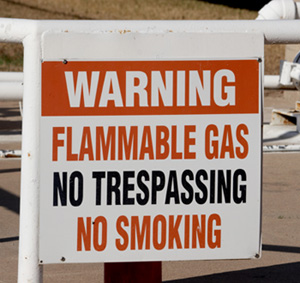Fire Extinguisher : 101
Class B Fires: How to Fight Them
| Home |
| About Fire Extinguishers |
| Using a Fire Extinguisher |
| Fire Prevention |
| Fire Hazards |
| First Aid for Fire |
| Financial Protection |
| Biggest Fires in History |
| Firefighters |
This site was voted:

by onlinefiresciencedegree.org
(scroll to 74 on the list)
This page provides information about class B fires. |
Fires are designated based on the condition of the burn, as well as the fuel. While common class A types feed on ordinary combustibles, class B fires burn combustible gas or liquids. This type of fire requires a slightly different approach than the class A fire in order to control and combat its dangerous spread.
 What
Are Combustible Gases and Liquids?The term combustible means
to burn or ignite easily; the opposite is incombustible or non-combustible,
which refers to material that does not burn. Combustible liquids and gases
are the fuel that determine the class B designation and include the following:
What
Are Combustible Gases and Liquids?The term combustible means
to burn or ignite easily; the opposite is incombustible or non-combustible,
which refers to material that does not burn. Combustible liquids and gases
are the fuel that determine the class B designation and include the following:
- Gasoline and diesel
- Ethanol and methanol
- Isopropanol
- Acetone
- Acetylene
- Methane
- Butane
- Propane
Class B fires have the same basic elements as their class A counterparts, that is, in order to burn there must be fuel, oxygen, heat, and a prolonged chemical reaction, termed the fire tetrahedron, as a group.
This type of fire can be contained and often burns out quickly if the fuel source is cut off, as in a BBQ grill. However, when most of the elements are present yet dormant, once the final part of the tetrahedron is added, the flames can be incredibly fast and destructive.
Fighting Class B Fires
Due to the characteristics of the fuel involved in class B fires,
it is important not to use water to extinguish the flames. In most cases,
a spray of water would not reduce the heat, but would actually serve to
spread the fuel farther, causing more damage.
Smothering the flames and reducing the oxygen supply is the best method of combat against this type of fire, and so foam is a commonly used weapon against class B conditions. In the case of a kitchen stovetop fire, sodium bicarbonate (baking soda) or potassium carbonate are effective ways to smother the flames. It is smart to keep these ingredients close at hand.
Firefighting Equipment
To fight class B fires, firefighters must have a dry chemical
flame retardant extinguisher in order to break up or stop the chemical
reaction that propagates the flames. CO2, which is commonly available
in extinguishers, is another effective weapon against this designation
of fire.
Although Halon has been used in the past to fight fires burning combustible liquids and gas, it has recently been discontinued due to environmental concerns. Experts do recommend a chemical called FM-200 for use as a halogenated flame suppressant, although many firefighting units will initially opt for the other available choices.
Burning Class B Fires
If you plan on using the BBQ, be sure to have prime conditions.
Always keep your storage equipment clean and free from corrosion. Tackle
repairs to storage tanks and equipment right away, before the risk of
an uncontrollable class B fire becomes high.
Have a class B rated extinguisher nearby when burning propane or natural gas and carry out routine maintenance and inspection on a regular basis. Safety precautions reduce the very real risk of danger when class B fires get out of hand. And remember that water is not effective to combat this type of fire - call in the professionals.